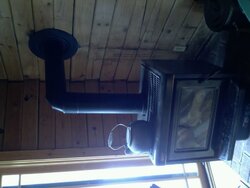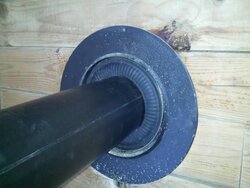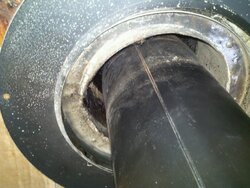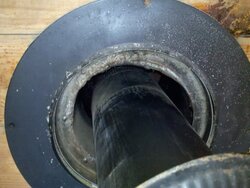Hey everybody-
So, looking for advice here. This is going to be a long one so feel free to stop reading now.
Situation:
House: Purchased house in September. Log home, ~2500 sq ft. Have since learned that every corner that previous owner could cut, has been cut.
Heating: Fuel oil burner and radiators (2 zones- 1st and 2nd floor), wood stove on main floor (Merlin 3, 1.8 cu foot non-cat stove), Dellpoint Europa 75 pellet stove in basement, ventless LP fireplace in living room
Points to know/consider:
a) Wood stove is in one end of first floor, has 6" pipe that goes through 8" thimble into masonry chimney, 25', unlined. Goes up ~ 2-3 feet from stove, 90 degree turn and out horizontally through wall into chimney.
b) Wood stove probably handles 60-70% of heating with fans to move air around, etc. Only problem is opposite end of main floor (living room, of course) gets cold so we use the LP fireplace to keep that room warm.
c) at night, we use a space heater (sealed oil space heater) to heat master bedroom upstairs
d) novice burner... bought some "seasoned" wood in the fall (hehe) so have been dealing with somewhat green wood. Have been removing the 6" flue pipe to clean every 2 weeks. But, overall stove has been working well, cranking out some heat (despite fact that it's a 20 yr old new zealand stove- still on EPA certified list, works well). Have probably burned through about 2.5 cords thus far this winter in Northwest CT. Find that i'm spending a lot of time with stove and house gets cold at times (after long shifts, overnights, etc). Probably limits of 1.8 cubic ft firebox, bad wood, etc.
e) Pellet stove in basement is a bust... have cut vents in basement door, put 2 vents in floor but aside from having 70 degree basement, used numerous fans but can't get the heat out of the basement. pellet stove is parked in little corner/alcove of basement opposite basement stairway door.
So, hopefully that covers the background. Here is the most recent problem/issue:
We have occasionally noticed smokey smell in house, attributed to stove door being open. But, have discovered some leakage at thimble and one of the stove pipe junctions lately. Was exaggerated the other night when it was very windy (house was pretty smokey, scary moment). Will post a pic below to illustrate. Talked to a stove/chimney guy today and he thinks that lining chimney is 1st and foremost to do given smoke leaking back into house.
So, here are my problems that i can identify (going to restrict to the woodburning stove as goal is for it to be primary heat source):
1) Unlined chimney
2) BAD thimble/pipe interface.
3) Bad wood +/- small stove +/- non-central location of stove
In closing, trying to figure out what to do here. Figured these are the options:
1) Quick fix: Fix the pipe/thimble issue and continue burning through unlined chimney
2) Better fix: Fix pip/thimble and get chimney lined
3) Best fix: Fix pipe/thimble, line chimney, and upgrade stove +/- OAK kit
4) Alternative fix: Move pellet stove from basement to mainfloor and vent into unlined chimney (this is the cheapest, quickest fix and thus don't want to line chimney)
At this point, we are at a "crossroads" in life where we'll either be living here for only 3-4 yrs longer or possibly the next 20+. Won't know that for 2-3 more years.
So, we are looking at all our options but unfortunately finances are a big part of it. I'm looking at getting serious about having 8-10 cords of wood delivered to process to get a 2-3 yr head start, have started dabbling in chainsaws, etc. But... finances are definitely finite.
I don't have a quote on getting chimney lined but i'm bracing for $1-2K. One the one hand, i'm looking forward to woodburning, processing wood and the effort/joy of it. (Having had just a taste of it this winter, it is awesome). On the other hand, just wondering if i'm better off just sucking it up and paying the propane man. The time saved could be better used picking up extra shifts at work... coupled with chance of possible return to grad school this summer makes it an appealing choice.
After all that rambling, i guess it comes down to a few questions:
1) If i can seal/fix thimble, how bad is burning into unlined chimney (given my issues with smoke, obviously i have a draft issue... then again, did "ok" for the last 2 months)
2) (and i will likely post this in pellet forum but..) Can i vent pellet stove into unlined chimney?
Cost wise, i see $1-2K for liner, $700-800 wood, another couple hundred to rent splitter (chainsaw costs aside.... i need a good saw with my property so that's not an issue). For only a couple of years, is it worth the cost? I just am wondering what's best for my family/finances... all things the same, i'd rather go the woodburning route.
So, looking for advice here. This is going to be a long one so feel free to stop reading now.
Situation:
House: Purchased house in September. Log home, ~2500 sq ft. Have since learned that every corner that previous owner could cut, has been cut.
Heating: Fuel oil burner and radiators (2 zones- 1st and 2nd floor), wood stove on main floor (Merlin 3, 1.8 cu foot non-cat stove), Dellpoint Europa 75 pellet stove in basement, ventless LP fireplace in living room
Points to know/consider:
a) Wood stove is in one end of first floor, has 6" pipe that goes through 8" thimble into masonry chimney, 25', unlined. Goes up ~ 2-3 feet from stove, 90 degree turn and out horizontally through wall into chimney.
b) Wood stove probably handles 60-70% of heating with fans to move air around, etc. Only problem is opposite end of main floor (living room, of course) gets cold so we use the LP fireplace to keep that room warm.
c) at night, we use a space heater (sealed oil space heater) to heat master bedroom upstairs
d) novice burner... bought some "seasoned" wood in the fall (hehe) so have been dealing with somewhat green wood. Have been removing the 6" flue pipe to clean every 2 weeks. But, overall stove has been working well, cranking out some heat (despite fact that it's a 20 yr old new zealand stove- still on EPA certified list, works well). Have probably burned through about 2.5 cords thus far this winter in Northwest CT. Find that i'm spending a lot of time with stove and house gets cold at times (after long shifts, overnights, etc). Probably limits of 1.8 cubic ft firebox, bad wood, etc.
e) Pellet stove in basement is a bust... have cut vents in basement door, put 2 vents in floor but aside from having 70 degree basement, used numerous fans but can't get the heat out of the basement. pellet stove is parked in little corner/alcove of basement opposite basement stairway door.
So, hopefully that covers the background. Here is the most recent problem/issue:
We have occasionally noticed smokey smell in house, attributed to stove door being open. But, have discovered some leakage at thimble and one of the stove pipe junctions lately. Was exaggerated the other night when it was very windy (house was pretty smokey, scary moment). Will post a pic below to illustrate. Talked to a stove/chimney guy today and he thinks that lining chimney is 1st and foremost to do given smoke leaking back into house.
So, here are my problems that i can identify (going to restrict to the woodburning stove as goal is for it to be primary heat source):
1) Unlined chimney
2) BAD thimble/pipe interface.
3) Bad wood +/- small stove +/- non-central location of stove
In closing, trying to figure out what to do here. Figured these are the options:
1) Quick fix: Fix the pipe/thimble issue and continue burning through unlined chimney
2) Better fix: Fix pip/thimble and get chimney lined
3) Best fix: Fix pipe/thimble, line chimney, and upgrade stove +/- OAK kit
4) Alternative fix: Move pellet stove from basement to mainfloor and vent into unlined chimney (this is the cheapest, quickest fix and thus don't want to line chimney)
At this point, we are at a "crossroads" in life where we'll either be living here for only 3-4 yrs longer or possibly the next 20+. Won't know that for 2-3 more years.
So, we are looking at all our options but unfortunately finances are a big part of it. I'm looking at getting serious about having 8-10 cords of wood delivered to process to get a 2-3 yr head start, have started dabbling in chainsaws, etc. But... finances are definitely finite.
I don't have a quote on getting chimney lined but i'm bracing for $1-2K. One the one hand, i'm looking forward to woodburning, processing wood and the effort/joy of it. (Having had just a taste of it this winter, it is awesome). On the other hand, just wondering if i'm better off just sucking it up and paying the propane man. The time saved could be better used picking up extra shifts at work... coupled with chance of possible return to grad school this summer makes it an appealing choice.
After all that rambling, i guess it comes down to a few questions:
1) If i can seal/fix thimble, how bad is burning into unlined chimney (given my issues with smoke, obviously i have a draft issue... then again, did "ok" for the last 2 months)
2) (and i will likely post this in pellet forum but..) Can i vent pellet stove into unlined chimney?
Cost wise, i see $1-2K for liner, $700-800 wood, another couple hundred to rent splitter (chainsaw costs aside.... i need a good saw with my property so that's not an issue). For only a couple of years, is it worth the cost? I just am wondering what's best for my family/finances... all things the same, i'd rather go the woodburning route.






